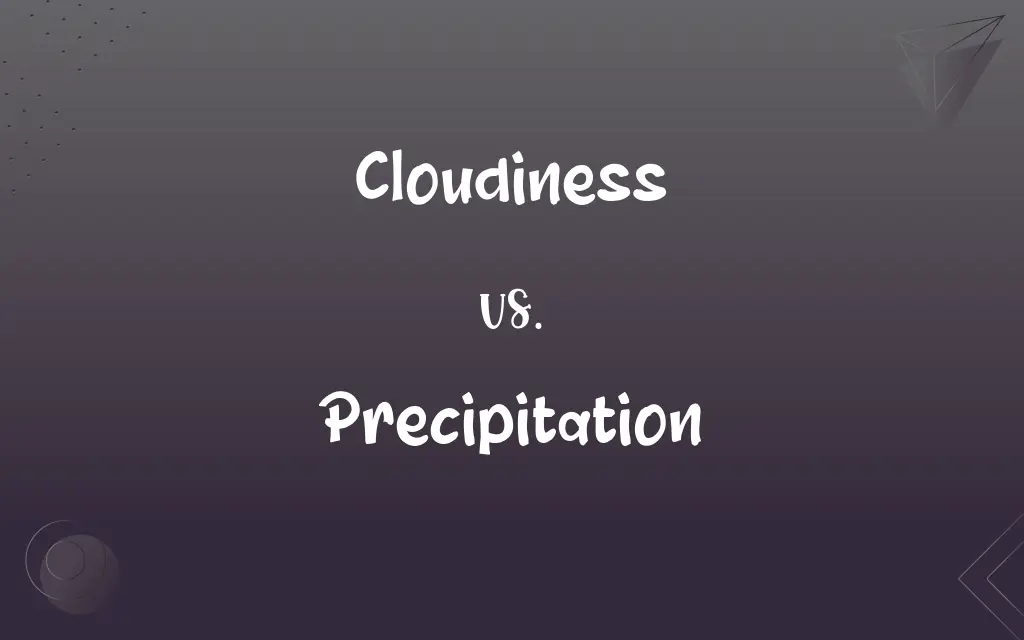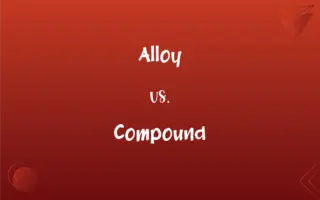Cloudiness vs. Precipitation: What's the Difference?
Edited by Aimie Carlson || By Harlon Moss || Updated on October 23, 2023
Cloudiness refers to the amount of clouds covering the sky, while precipitation denotes any form of water, like rain or snow, that falls from clouds to the earth.

Key Differences
Cloudiness is a measure indicating the extent to which the sky is covered by clouds. It's typically expressed as a percentage, with 0% being a clear sky and 100% being completely overcast. On the other hand, precipitation is a term that encapsulates all forms of water, whether liquid or solid, that fall from the atmosphere and reach the ground. This includes rain, snow, sleet, and hail.
When meteorologists talk about cloudiness, they're referring to the visual appearance of the sky and how much of it is obscured by clouds. It doesn't necessarily imply that there will be rain or snow. Conversely, precipitation is a direct reference to moisture falling from the sky. You can have cloudiness without precipitation, but precipitation always involves some level of cloudiness.
In certain situations, a sky filled with clouds (cloudiness) doesn't result in any form of water reaching the ground. Factors like humidity, temperature, and cloud type determine whether clouds will lead to precipitation. For instance, high cirrus clouds might make the sky look cloudy but rarely result in rain or snow.
Cloudiness is a vital metric for various activities, including aviation and astronomy, as it affects visibility and light conditions. Precipitation, meanwhile, has a more direct impact on daily life, affecting agriculture, outdoor plans, and even the mood of individuals. Both are essential components of weather forecasts, helping people prepare for their day and anticipate weather changes.
Comparison Chart
Definition
Amount of cloud cover in the sky
Water falling from the sky in various forms
ADVERTISEMENT
Measurement
Typically expressed as a percentage
Measured in terms of amount or intensity
Indicates
Sky's visual appearance
Moisture falling from the sky
Outcome
May or may not lead to precipitation
Always involves moisture reaching the ground
Relevance in Forecasting
Helps in predicting light conditions and visibility
Crucial for predicting rain, snow, sleet, or hail
Cloudiness and Precipitation Definitions
Cloudiness
A condition where the sky is obscured by clouds.
The constant cloudiness in Seattle is typical during the fall.
ADVERTISEMENT
Precipitation
The meteorological phenomenon of moisture dropping from clouds.
We need to carry umbrellas due to the expected precipitation.
Cloudiness
The degree to which clouds cover the sky.
The cloudiness made it difficult to observe the stars.
Precipitation
Rain, snow, sleet, or hail that falls to the ground.
The precipitation turned from rain to snow as the temperature dropped.
Cloudiness
The presence or abundance of clouds in the atmosphere.
Today's cloudiness is expected to clear up by the evening.
Precipitation
Moisture that condenses and falls from clouds.
The forecast predicts heavy precipitation throughout the week.
Cloudiness
The visual state of the sky being covered by clouds.
The cloudiness didn't promise good weather for the picnic.
Precipitation
Any form of water falling from the sky.
The precipitation last night helped the crops immensely.
Cloudiness
A meteorological term describing cloud cover extent.
Despite the cloudiness, no rain was forecasted for the day.
Precipitation
The act or process of water being released from the atmosphere.
The precipitation levels this month have been above average.
Cloudiness
Full of or covered with clouds; overcast.
Precipitation
Any form of water, such as rain, snow, sleet, or hail, that falls to the earth's surface.
FAQs
How is cloudiness usually measured?
Cloudiness is typically measured as a percentage of cloud cover.
Can precipitation occur without clouds?
No, precipitation always involves some level of cloudiness.
What are the different forms of precipitation?
Precipitation includes rain, snow, sleet, and hail.
What does cloudiness indicate in weather terms?
Cloudiness indicates the extent to which the sky is covered by clouds.
How does precipitation impact agriculture?
Precipitation provides essential water for crops, but excessive amounts can be harmful.
What causes precipitation to occur from clouds?
Precipitation occurs when water droplets in clouds combine, become heavy, and fall.
Does cloudiness affect temperatures?
Yes, cloudiness can trap heat, leading to warmer nights, and block sunlight, causing cooler days.
Is snow a form of precipitation?
Yes, snow is a solid form of precipitation.
How does cloudiness affect aviation?
Cloudiness can affect visibility, making flying conditions challenging.
Is drizzle a form of precipitation?
Yes, drizzle is a light form of liquid precipitation.
What happens when precipitation is acidic?
Acidic precipitation or acid rain can harm ecosystems, structures, and human health.
Can a day be cloudy without any precipitation?
Yes, cloudiness doesn't always lead to precipitation.
Does cloudiness affect solar panel efficiency?
Yes, high cloudiness can reduce the sunlight reaching solar panels.
Can cloudiness be predicted accurately?
While forecasts can estimate cloudiness, atmospheric conditions can change rapidly.
What instruments measure precipitation?
Instruments like rain gauges and disdrometers measure precipitation.
How does cloudiness influence photography?
Cloudiness provides diffused lighting, which can be ideal for certain photography types.
Does cloudiness play a role in climate change?
Cloudiness can influence Earth's energy balance, thus playing a role in climate dynamics.
Can precipitation cleanse the air of pollutants?
Yes, precipitation can wash away airborne particles, cleaning the air.
Can cloudiness be a sign of an approaching weather system?
Increased cloudiness often indicates an approaching front or weather system.
Why does precipitation vary across different regions?
Precipitation varies due to factors like altitude, proximity to water bodies, and atmospheric currents.
About Author
Written by
Harlon MossHarlon is a seasoned quality moderator and accomplished content writer for Difference Wiki. An alumnus of the prestigious University of California, he earned his degree in Computer Science. Leveraging his academic background, Harlon brings a meticulous and informed perspective to his work, ensuring content accuracy and excellence.
Edited by
Aimie CarlsonAimie Carlson, holding a master's degree in English literature, is a fervent English language enthusiast. She lends her writing talents to Difference Wiki, a prominent website that specializes in comparisons, offering readers insightful analyses that both captivate and inform.































































